RPGs are bigger than ever. With over 3.3 billion gamers worldwide, it’s clear people love building characters, exploring massive worlds, and figuring out the best gear. But here’s the wild part: despite all that effort, a lot of players are still equipping weapons that just don’t make sense for their class. And that one mistake? It can throw off your game.
There’s nothing like the rush of landing that perfect weapon in an RPG. It’s like your character steps into their true role, whether that’s a shadowy rogue, a noble paladin, or a battle-scarred barbarian. It fits your playstyle, matches your character’s vibe, and suddenly everything starts clicking.
It’s no surprise that the majority of players spend over 10 minutes just choosing a weapon. One wrong move can be the line between glory and endless respawns. Choose wisely.
So, what really makes a weapon perfect for your character? Is it all about massive damage, faster strikes, or those cool special effects? And how much should your class play into the decision? Don’t worry, we’re about to unpack how to choose weapons that align with your character’s strengths, using a balance of game mechanics and strategy, but first, we will list down the best RPG weapons.
What Is a Weapon in an RPG?
A weapon in RPGs serves more purposes than just striking your opponents. It should always be a focus when practicing your strategy in the game. Depending on whether you use a broadsword, magic staff, sniper rifle, or a pair of daggers, your character will handle combat differently.
Weapons in RPGs typically carry particular stats like:
- Damage output (how much damage it does)
- Attack speed (how quickly you can strike)
- Range (melee or ranged)
- Special effects (such as poison, fire damage, lifesteal, or stun)
- Class compatibility (some weapons are suited better—or exclusively—to certain classes)
Some RPGs even provide the option to upgrade, enchant, or customize your weapons, which thus becomes an integral part of your character development.
How Does an RPG Weapon Impact Player Strategy and Engagement?
An RPG weapon isn’t just a damage dealer; it’s a cornerstone of your combat style and progression. The right weapon defines how players approach encounters, manage resources, and even interact with the world around them.
According to Unity’s Gaming Report 2024, over 72% of RPG players prefer weapon systems that offer strategic depth and skill-based mechanics. This means players aren’t just chasing numbers; they’re making meaningful decisions around timing, positioning, and enemy types.
1. Player Focus on Weapon Customization
In Call of Duty: Warzone 2.0, players spend $3,000 per weapon attachment, with a fully upgraded weapon costing around $15,000 in-game currency. This highlights the depth of weapon customization—even in non-RPG titles—creating tangible progression goals and personal investment in gear.
2. Diverse Build Preferences in RPGs
Analysis of Puzzle Quest shows 90% of players consistently choose specific rune combinations (like Rune of Swords or Rune of Poison), indicating that players gravitate toward builds tailored to weapon stats and effects.
In games with attribute-scaling weapons (e.g., Dark Souls/Elden Ring), designers note that weapon scaling tied to Strength/Dex/Int stats (rated D–B) enables players to grow into a weapon, supporting long-term strategic investment.
3. Preventing Complacent Gaming Syndrome
Game developers warn that without robust weapon customization, players may default to “top-tier” gear, reducing strategic diversity. Adding customization options like adjusting weapon length, weight, reach, and speed fosters experimentation and deeper engagement.
Tips to Choose the Best RPG Weapon for Your Character
Choosing one weapon over another in an RPG is a strategic choice that can determine the fate of your game. This is how to pick the most advantageous weapon according to gameplay mechanics, character build, and your unique style of play.
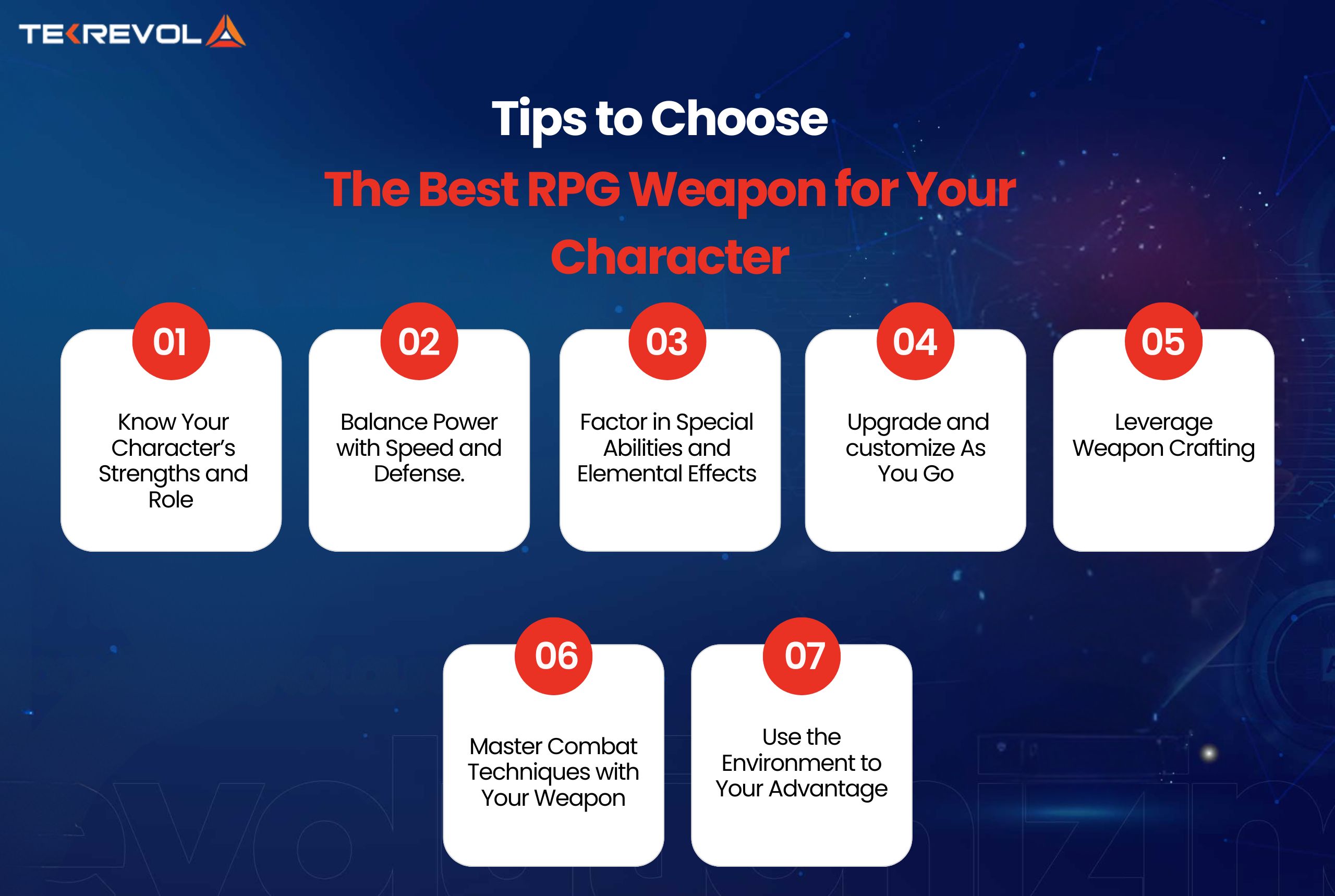
1. Know Your Character’s Strengths and Role
Begin by determining your character’s core attributes. Are you a high-endurance tank? Or maybe a fast, agile rogue? Perhaps a mage endowed with ranged or elemental powers?
Each archetype works best with specific weapon types.
- Warriors generally favor heavy melee-based weapons, inflicting raw damage.
- Rogues and Assassins prefer light weapons for stealth and speed.
- Mages or Sorcerers prefer magical staves or enchanted weapons to bolster their spells.
When your weapon matches your game character design, you optimize both performance and battle efficiency.
2. Balance Power with Speed and Defense.
Every weapon compromises; some are heavy but then become slow despite inflicting great damage. Some move at lightning speed, yet they barely scratch the surface when it comes to actual impact. Now think through your approach to engaging enemies:
- Heavy weapons (greatswords, warhammers) hit hard but can leave you exposed.
- Light weapons (daggers, short swords) offer speed and critical strike potential.
- Medium weapons (spears, one-handed swords) provide balance and flexibility.
Get what works with how you like to fight – aggressive, reactive, or tactical.
3. Factor in Special Abilities and Elemental Effects
In most RPGs, powerful weapons don’t stay static. You’ll find blacksmiths, upgrade stones, or skill trees that allow you to enhance or modify your gear.
- Fire or ice enchantments burn or freeze enemies.
- Shows more use of “hit and run”: increased speed, life return, and critical hit chances are the “passive” perks.
- Effects like poison, stun, or damage over time due to bleeding.
Pick the best weapon possible to counteract the combat style or help against the weaknesses of a boss. When it comes to modeling RPG weapons, your choice of tools can impact everything from visual style to animation flow. Two of the most widely used tools are Maya and Blender.
4. Upgrade and customize As You Go.
In every epic RPG, legendary weapons don’t just fade with time—they evolve, growing stronger with the help of tocadors, enchanted stones, or intricate skill trees.
- Upgrade core stats like damage and durability.
- Modifiers such as elemental value or even a longer range are added to the mix.
- Respeccing/Reforging a weapon to bring it into accord with an ever-changing build.
Never just run after legendary ones; engage your pursuit on those weapons that will yield higher returns on your strategy by having them upgraded instead.
5. Leverage Weapon Crafting
RPG crafting systems allow you to craft weapons from the ground up from resources within the game world. It is an excellent method of making your arsenal more personalized.
- Mix rare resources to create unusual bonuses.
- Craft weapons that tie into your character’s history or narrative progression.
- Play around with combinations to reveal secret synergies.
Crafted weapons tend to surpass loot-based versions after fully optimizing them.
6. Master Combat Techniques with Your Weapon
A powerful weapon wielded by an inexperienced player may still fall short. Master the subtleties of timing, movement, and combo chaining.
- Practice parrying, dodging, and counter-attacking.
- Make use of weapon skills or class-based abilities effectively.
- Know when to push forward and when to fall back.
The more familiar you are with the rhythm of your weapon, the deadlier you will be in combat.
7. Use the Environment to Your Advantage
Intelligent players don’t simply use brute strength, they learn to fit into their environment.
- Utilize terrain as cover or as a high position.
- Attract foes into ambushes or constricted areas where your weapon is superior.
- Observe enemy habits and respond according to them.
A spear works wonderfully in narrow corridors, a bow in open plains. Allow the battlefield to dictate your decisions as well.
- Want to build your own RPG weapon?
- Share your preferences with us, we’ll help you craft the perfect gear.
Note:
These are the most significant aspects every player should consider when selecting any weapon in any RPG. However, to give you a more significant and informed understanding, we’ve also listed the different types of RPG weapons along with their typical uses.
This classification will help you visualize how each weapon works in different scenarios in gameplay so that you can choose the one that suits your character and in-game intentions perfectly. So, have a look.
Different Types of Weapons Every RPG Player Should Know
In most RPGs, weapons are classified into several different categories depending on how they work and how the players use them. Each category offers a different kind of combat experience; some are close and brutal, some are best when used from far away, and some involve elemental or supernatural abilities.
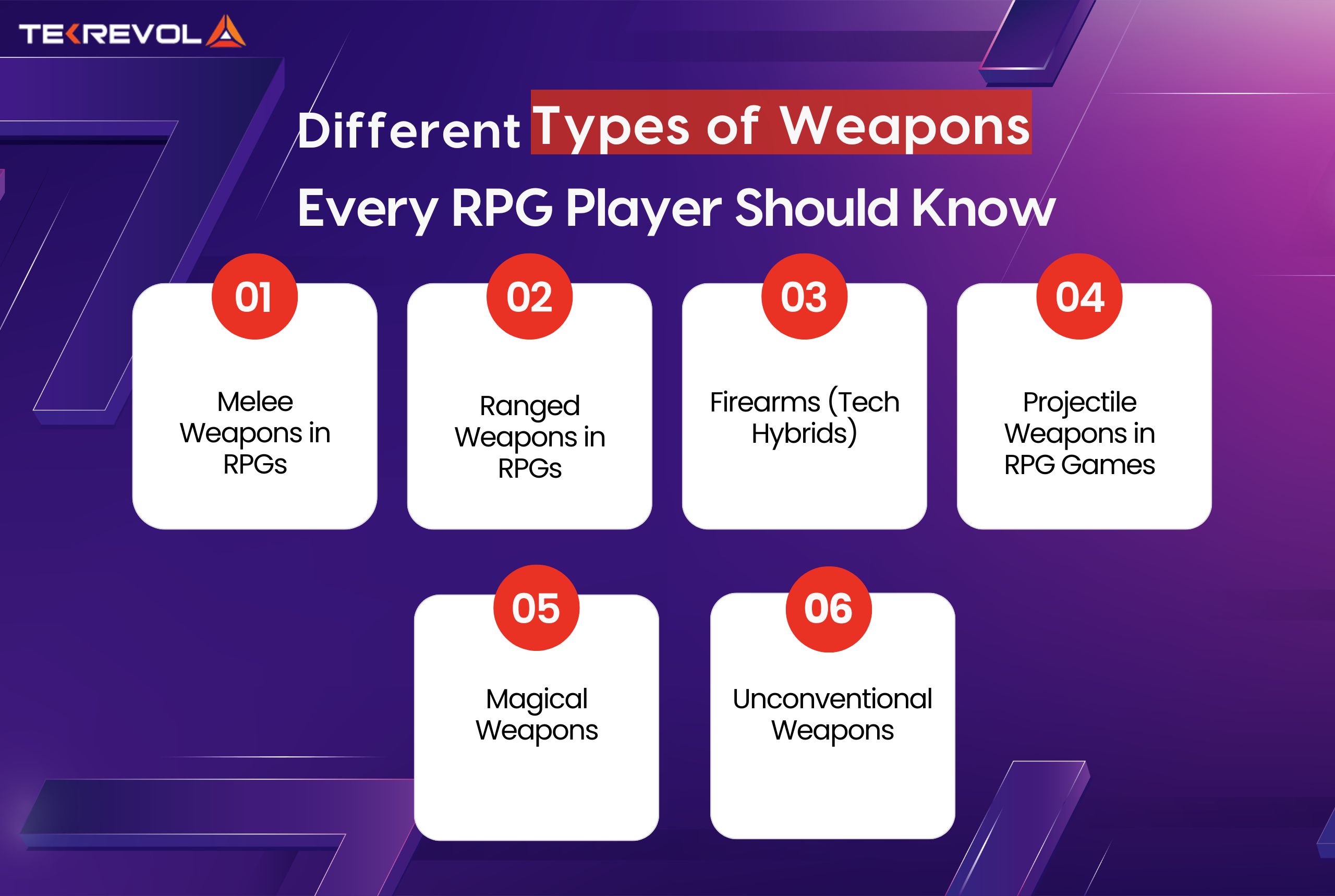
For those who seek more than the ordinary, hybrid weapons offer a path that blends power, unpredictability, and innovation.
The weapons available in any RPG are usually shaped by the game’s storyline, period, and character classes. If you’ve ever caught yourself wondering what kind of weapon suits your playstyle best, understanding the main types and how they work is the perfect place to start.
1. Melee Weapons in RPGs
Most RPGs rely heavily on melee weapons for close-range fighting. Such weapons require players to get up close to enemies, focusing on moving smoothly, taking advantage of good timings, and choosing nice locations. There are many melee weapons to use, ranging from smaller daggers to the much larger hammers.
All melee weapons fulfill a unique role on the battlefield, enhancing the way certain characters are designed and played. Here is a review of the different kinds of melee weapons used in RPGs, the many forms they can take, and the way you should use them in the game.
Swords
In RPGs, swords are often valued as melee weapons for being fast, powerful and useful in various situations. When playing offensively or defensively, swords are dependable for knights, rogues and explorers.
Types and Applications:
- Shortswords: They are fast, lightweight, and best for performing multiple quick attacks and having two in your hands. Merchants will love to use this style for thieves, rogues, or characters focused on dexterity.
- Longswords/Broadswords: Very versatile weapons that work when held with one hand or two. Suitable for frontline brawlers.
- Greatswords: Enormous two-handers with high damage potential and broad attack ranges. Best for strong, tanky characters with the capacity to absorb slow attacks.
- Curved Swords: Famous for their quick slapping motion and critical-hit capabilities. Typically wielded by Eastern-inspired or assassin-type characters.
Axes
Axes are high-damage melee weapons famous for their raw destructive capability. Slower than swords, but able to cleave armor and dish out heavy burst damage, they are not to be underestimated.
Variants and Uses
- Hand Axes: Moderately fast one-handers with good damage for barbarian or berserker characters.
- Battle Axes: More damaging, one-handed axes with more stagger value.
- Great Axes: Two-handed monsters that pack huge damage but have high weight, suitable for crowd-control or rage-based characters.
- Throwing Axes: Suitable for hybrid melee-ranged characters with the ability to attack faraway enemies.
Maces, Hammers, and Flails
They are best known for breaking through tough defensive lines and crumbling enemies. These weapons specialize in hitting with great strength and are very effective against densely armored opponents.
Variants and Uses:
- Maces: Small, blunt weapons suited for one-handed use. Typically used with shields for defensive playstyles.
- War Hammers: They’re larger and stronger, and because you hold them with two hands, you deal damage to multiple enemies at once.
- Flails: Flails are best used by fighters who like to attack head-on, since they go around shields by striking with sheer force.
Daggers and Knives
Quick to use, quie,t and very precise, knives and daggers are common tools for characters in rogue-like games. They are experts in performing fast attacks, delivering fatal blows, and completing their attacks without being seen.
Variants and Uses:
- Single Daggers: Applied to silent take-downs and rapid jabs. Generally enchanted or poisoned for increased deadliness.
- Dual Daggers: Ideal for players who value speed above defense, delivering a swift barrage of strikes that catch enemies off guard.
- Throwing Knives: An adaptable weapon that lets players strike from a distance while preserving their stealthy, assassin style.
- Elemental Daggers: Often used in role-playing games to apply persistent damage and target enemies’ elemental weaknesses.
Spears and Polearms
Polearms provide greater reach, enabling space control and keeping enemies at a safe distance. They’re usually wielded by well-disciplined warriors, temple guards, or tactical characters with a focus on positioning.
Variants and Uses:
- Spears: Light and agile, great for thrusting. Tend to be used in skirmish or tactical positions.
- Halberds: They are a combination of a spear and an axe for both stabbing, cutting, and hooking.
- Tridents: Common among magical or elemental characters for their three-tipped shape and varying attack patterns.
Knuckles, Claws, and Fist Weapons
For players who enjoy close-quarters combat, these weapons are designed to hit your foes rapidly and with accuracy, rather than overwhelming strength.
Variants and Uses:
- Brass Knuckles: With Brass Knuckles, you handle unarmed combat with greater ease, especially suited to brawlers.
- Claws: Fast weapons that allow for quick and forceful cuts. Recommended for those playing as feral or beastman characters.
- Gauntlets: Gauntlets are upgraded gloves that make your punches much stronger. Sometimes enchanted with special element damage.
- Unarmed Combat: Players have to use their skills to dodge and launch combos without weapons in unarmed combat.
2. Ranged Weapons in RPGs
In many RPGs, ranged weapons give players an edge by allowing them to keep their distance from opponents. In these situations, players who care about getting a good position, shooting accurately, and understanding the surroundings will have an edge.
Whether shooting enemies from the trees or firing magical arrows at a distance, ranged weapons are a versatile and frequently strategic way around melee combat. Below is an in-depth examination of the main ranged weapon types seen in most RPGs.
Bows
Bows are silent, versatile, and usually the first ranged weapon encountered by players. They employ arrows as ammunition, which can be augmented with elemental properties or magical effects to produce specialized damage.
Variant and Uses:
- Shortbows: Quick draw time and lightweight make them ideal for rapid shots and mobility-focused playstyles.
- Longbows: High-range, accurate weapons ideal for hunting or sniper styles. Cause additional damage at a distance.
- Composite Bows: Made for an equilibrium of power and speed, suitable for archers who prefer flexibility.
- Enchanted Bows: Charged with elemental or magical properties such as fire, frost, or lightning for dedicated attacks.
- Special Arrows: Arrows can have effects such as poison, paralysis, or explosive impact, allowing various strategies per engagement.
Crossbows
Crossbows launch forceful, high-damage projectiles called bolts. They’re simple to aim and excellent for beginners, although they usually have slower reload times compared to bows.
Variants and Uses:
- Light Crossbows: Provide faster reloads and medium power, perfect for players who prioritize agility and support abilities.
- Heavy Crossbows: High damage but slow reloading, ideal for players who can afford stationary sniping or cover-based play.
- Repeating Crossbows: Combining exotic craftsmanship with magic, they shoot multiple bolts swiftly, exchanging accuracy for greater impact.
- Special Bolts: Like arrows, bolts can be tipped with elemental or poison effects for extra damage or usefulness.
Thrown Weapons
Throwing weapons fill the gap between melee and ranged combat, providing quick, direct attacks from a distance.
Variants and Uses:
- Throwing Knives: Light, swift, and ideal for stealthy takeouts or deception tactics.
- Throwing Axes: Denser and more destructive than knives, usually employed by warrior-hybrid characters.
- Javelins and Spears: Thrown for heavy ranged assault, often picked up after combat.
- Chakrams and Boomerangs: Exotic weapons that can fly back to their users, enabling continuous attack without ammo expenditure.
3. Firearms (Tech Hybrids)
Firearms are a strong and varied category of ranged weapons that provide huge damage and accuracy. Not usual for high-fantasy worlds, but usual in contemporary, post-apocalyptic, and steampunk RPGs. Firearms have different ranges, firing rates, and ammo consumption, providing players with several tactical opportunities.
The following are the main types of firearms you may find in RPGs:
Runeshot Pistols
Runeshot Pistols are perfect for fast characters who are dependent on speed and mobility. Sidearms that marry the mechanical to the arcane, Runeshot Pistols enable spell-gunners to weave magic into each bullet.
Variants and Uses:
- Flamebrand Runners: Ignite enemies on impact, ideal for setting traps or flushing foes out of cover.
- Frostbiters: Slow down enemy targets with frozen bullets, ideal for controlling crowds or pursuing retreating enemies.
- Echo Bolters: Delivers fiery impact that lights enemies up, useful for flushing out hidden threats.
- Shadow Shots: Employ black energy to lower enemy resistance for subsequent close combat.
Arc-Rifles
These long-barreled rifles bring elemental forces into focused blasts. Arc-Rifles are highly accurate and deal high elemental damage, making them lethal when wielded by snipers or tech-mages.
Variants and Uses:
- Assault Rifles: Effective in the majority of combat situations, providing sustained fire with good accuracy and recoil control.
- Sniper Rifles: Best suited for gamers who like hiding and shooting targets from a distance.
- Battle Rifles: A strategic option for users who prefer maximum damage with or without full-auto fire.
- Shotguns: A heavy hitter up close, perfect for ambushes and hallways.
- Dual-Wielded Guns: Provides constant fire from both hands—ideal for aggressive, mobile fighting styles.
Shotguns
Shotguns excel at close distances with high burst damage and large spread. Great for room clearing or swarming enemies up close.
- Pump-Action: Slow but deadly.
- Semi-Auto: Higher rate, lower per-shot power.
- Double-Barreled: Killer two-shot burst but low ammo.
Automatic Firearms
Automatic weapons spew out a stream of bullets endlessly, the best option for intense combat encounters in cyberpunk, sci-fi, or dystopian RPGs. Engineered for continuous fire and area denial, these weapons are trusted by high-ranking soldiers, augmented enforcers, and contract killers across star systems.
They sacrifice pinpoint accuracy for sheer volume of fire, enabling players to overwhelm foes with constant barrages. Automatic guns usually complement tech-oriented builds and characters that favor sheer force over accuracy.
Variants and Uses:
Storm Reapers: Light machine guns with high capacities that are best used for laying down suppressive fire. Suitable for frontline tank characters or holding defensive positions.
Venom Strikers: Equipped with toxin-dispensing systems, these rifles deal poison damage over time. Excellent to debilitate bosses or drive out stealth units.
Shredstorm Miniguns: Mounted or heavy-held autos that compromise mobility in favor of pure firepower. Cut down waves of foes, ideal for crowd control or boss suppression.
Rift-Splitters: Shoot unstable ammunition that produces small spatial distortions, area-of-effect damage upon impact. Perfect for groups of enemies bunched up in cover or close quarters.
Energy Weapons (Sci-Fi Variants)
In sci-fi RPGs, guns transform into energy technology with special effects such as burning, stunning, or disintegration.
- Laser Rifles: Beam-based guns with high accuracy.
- Plasma Guns: Splash or burn damage from explosive energy.
- Railguns: Magnetic projectile accelerators with massive range and impact.
4. Projectile Weapons in RPG Games
Projectile weapons provide versatile, long-distance options for combat, the ideal solution for ambushes, support, or stealth gameplay. Found in fantasy, historical, and war-themed RPGs, projectile weapons heighten strategy by enabling players to attack without confrontation.
Throwing Knives
Lightweight and lethal, these knives are crafted for quick strikes and silent kills. Often enchanted in secret, they’re essential gear for any stealth-focused warrior.
Variants and Uses:
- Phantom Knives: Get invisible in mid-air, perfect for stealthy takeovers.
- Venom-Tipped Blades: Deal poison damage after a while, which weakens foes before close-range combat.
- Echo Daggers: Come back to their thrower after hitting, perfect for continuous long-range assault.
- Flamepiercers: Set the target on fire when they hit, perfect for burning environments.
Javelins, Lances, and Spears
Once held by battle heroes and ancient guardians, these sharp weapons are designed for strength and accuracy. Usually associated with the weapon of the hunter, guard, or mounted man.
Variants and Uses:
- Stormcall Javelins: Bring down thunder to strike dense enemy formations in one blow.
- Frost-Tipped Spears: It slows down enemies upon contact and is great for managing fast enemies.
- Sunforged Lances: Burn through armor, ideal for well-guarded targets.
- Soulpiercers: Skip over physical defense, striking directly at enemy vitality.
Boomerangs
Made from enchanted timbers or scarce metals, these weapons are frequently associated with tribal lore or ancient tests. Engineered to curve with lethal elegance and come back reliably to their user.
Variants and Uses:
- Windrider Boomerangs: Go farther and faster, striking from extreme distance.
- Twinspin Blades: Strike multiple targets before coming back.
- Gravity Benders: Bend in flight to track concealed or moving targets.
- Crimson Fangs: Triggers a bleed effect on contact, making it effective for long battles.
Chakras and Throwing Discs
These circular weapons, which are as deadly as they are symbolic, are typically associated with divine protectors or astral warriors. They swirl like fate itself might, slicing with grace and fury.
Variants and Uses:
- Lunar Chakras: Deal extra damage at night or in darkness.
- Mirror Discs: Reflect spells or projectiles, used defensively and offensively.
- Tempest Rings: Produce gusts of wind that push back enemies.
- Infernal Chakras: Spawn fire trails that hurt enemies along the way.
5. Magical Weapons
Magical weapons are imbued with arcane power, enabling players to utilize the powers of nature, time, and the unknown. Used to amplify spells or redirect the flow of combat, these objects are critical tools for any spellcaster or mystic warrior.
Amulets
These ancient amulets are mostly used for defense but may carry hidden magic for offense or support.
Variants and Uses:
- Amulet of Vitalis: Over time, it heals slowly; perfect for survival during prolonged wars.
- Runestone Pendant: Increases elemental resistance, particularly against fire, ice, or lightning magic.
- Charm of Echoes: Bounces a part of the magical damage back at the attackers.
- Karmic Loop: Slows down time when danger is present (like God of War’s Amulet of Kvasir).
Spellbooks / Grimoires
Ancient tomes wrapped in accursed leather or starlight-woven silk contain dangerous mantras and forgotten secrets. Erudite magicians use it to cast a variety of spells.
Variants and Uses:
- Codex Infernum: Cracks open high-damage fire spells at the expense of energy over time
- Book of Serene Winds: Bolsters healing and support spells, best suited for party-focused gameplay.
- Whispered Lexicon: Facilitates silent casting, convenient for stealth-oriented mages.
- Grimoire of Chaos: Randomizes spell impacts; dangerous, but deadly when fortunate.
Orbs
Handheld or floating vessels of raw magic, orbs enable the finesse of guiding spells and adding impact. They also tend to offer passive positive effects, making them suited for strategic spellcasters.
Variants and Uses:
- Frostcore Orb: Gives all ice spells a freezing effect, potentially paralyzing the target.
- Arcane Beacon: Enhances spell distance and accuracy, suited for long-range duels.
- Soulmirror Sphere: Allows the caster to see through illusions and magical deceptions.
6. Unconventional Weapons
Unconventional weapons challenge traditional combat norms, providing unique tools that combine secrecy, versatility, and surprise. These weapons, typically used by stealth-oriented or low-tier characters, bring tactical diversity and unexpected rewards to engagements.
Chains & Whips
These stretchy, mid-range weapons offer control effects like disarming and stunning, making them perfect for tactical dominance.
Variants and Uses:
- Serpent Lash: Toxic on contact; best used to weaken opponents over time.
- Ironbind Chain: Slows down or immobilizes enemies, great for crowd control or keeping enemies in place.
- Hellwhip: Fire-imbued, deals damage over time after each attack.
- Phantom Tether: Briefly immobilizes enemies in place while lowering their defenses.
Cloaks
Magical or weighted cloaks can be used not only for invisibility but also as surprise weapons, blinding, linking, or even strangling enemies in close combat. Spellcasters, rogue-warriors, and multiclass warriors frequently employ them.
Variants and Uses:
- Shroud of Silence: Provides temporary invisibility when employed defensively.
- Vineweave Cloak: Enchanted by nature magic, it can extend and trap several adversaries.
- Crimson Drape: Can be thrown over an enemy’s neck to strangle their grapple.
- Starlight Mantle: Deflects projectiles briefly while blinding opponents upon hit.
Blowpipes
Small and quiet, blowpipes are ideal for stealth characters. They fire tiny projectiles, commonly poisoned, that disable or distract foes from range without waking others up.
Variants and uses:
- Dart of Paralysis: Freezes targets momentarily in place; excellent for silent kills.
- Seedspitter: Shoots magical seeds that grow vines to immobilize enemies.
- Venom Breath: Fires a poisonous cloud that applies AoE poison damage.
- Echo Darts: Produce a sound diversion when striking surfaces, best suited for silent maneuvering.
Most Iconic Weapons in RPG History
RPGs are not all about quests and character progression; they also have some of the most memorable weapons in gaming technology. These weapons aren’t just for causing damage; they form characters, add depth to lore, and become symbols of entire franchises.
Here’s a closer examination of iconic RPG weapons that left an indelible imprint on players and pop culture.
1. Leviathan Axe – A New Era of Power
Appears in: God of War (2018–2022)
Leviathan Axe gave Kratos a new persona when God of War went full-on Norse mythology. Crafted with elemental frost damage and the tactile pleasure of being thrown and recalled, it was a weapon players came to feel. It replaced Kratos’ old rage-crazed berserking with something more disciplined, accurate, and symbolically weighted, a father’s weapon, rather than a warrior’s.
Why it’s iconic:
It combined mechanics with narrative, symbolizing Kratos’ internal evolution and presenting one of the most rewarding weapon systems in recent RPGs.
2. Master Sword – Blade of Destiny
Appeared in: The Legend of Zelda Series
The Master Sword isn’t simply another magical blade, it’s a coming-of-age experience. Hidden behind challenges or timegates, this sword selects its user when they’re deemed worthy. It’s deeply connected to Link’s role as the Hero of Time, frequently opening up new territories or abilities at the moment when they’re most necessary.
Why it’s iconic:
Its consistent presence across the Zelda timeline and its symbolism of good vs. evil make it more than just a sword, it’s a narrative milestone.
3. Buster Sword – Strength with Emotion
Appears in: Final Fantasy VII
Gigantic, cumbersome, unforgettable. The Buster Sword is not only Cloud Strife‘s iconic weapon — it’s also a reflection of the weight he bears. Its size is as imposing as his inner struggles, and as the game unfolds, the sword becomes just as iconic as his spiky hair and distant gaze.
Why it’s iconic:
It encapsulates the emotional significance of the tale and has become a visual shorthand for one of gaming’s most endearing RPGs of all time.
4. Keyblade – Where Magic Meets Meaning
Appears in: Kingdom Hearts Series
A blade that doubles as a key? It appears out of place at first glance, but that is before you start to explore the Kingdom Hearts universe. In addition to defeating evil, the Keyblade may seal broken hearts, open worlds, and change with the story. The ideals, connections, and experiences of its master are reflected in each Keyblade iteration.
Why it’s iconic:
It’s deeply connected to the lore, progression, and heart of the whole franchise, not just functional.
Partner with TekRevol to Build Custom RPG Weapons
Choosing the right RPG weapon isn’t just a creative decision; it is a development challenge. If you’re building a full-fledged game and need an expert mobile game development company that can bring your vision to life with professional-grade tools, balanced mechanics, and UI integration.
At TekRevol, we as one of the top game development companies in the USA recognize that fantastic weapon design goes beyond stats and looks; it’s about involvement, feeling, and rich gameplay engagement.
We specialize in custom weapon designs for RPGs and other games. Whether you need classic swords, enchanted staffs, modern firearms, or distinctive projectiles, our skilled designers build high-quality weapons that enhance the story and immerse players in your game world.
- Need help designing RPG weapons that stand out?
- We offer professional support to make your game truly engaging.

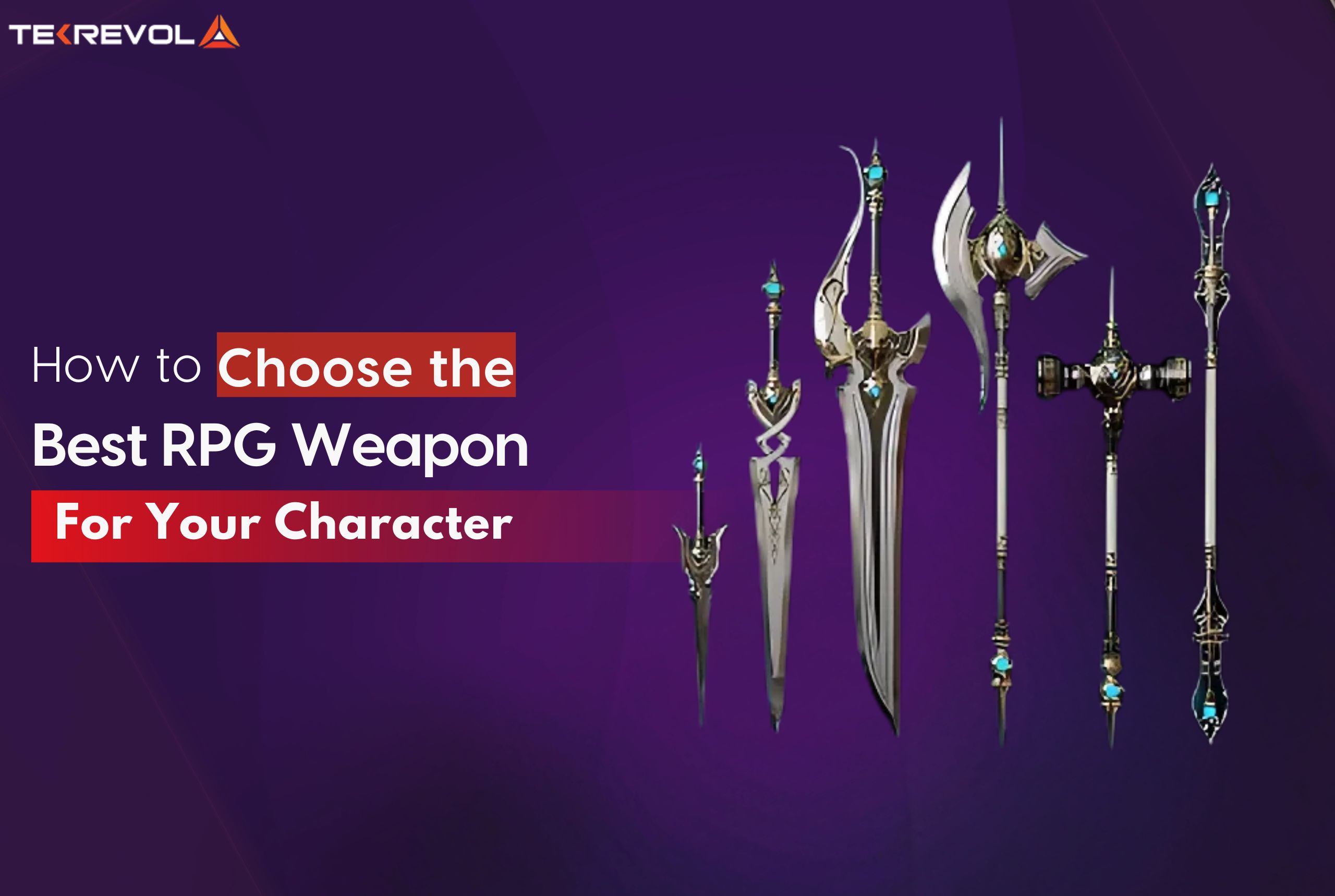
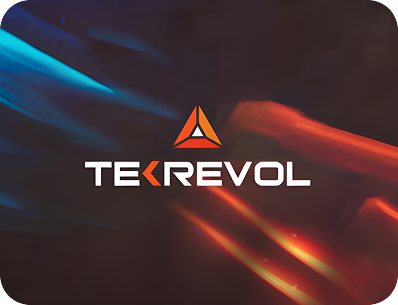
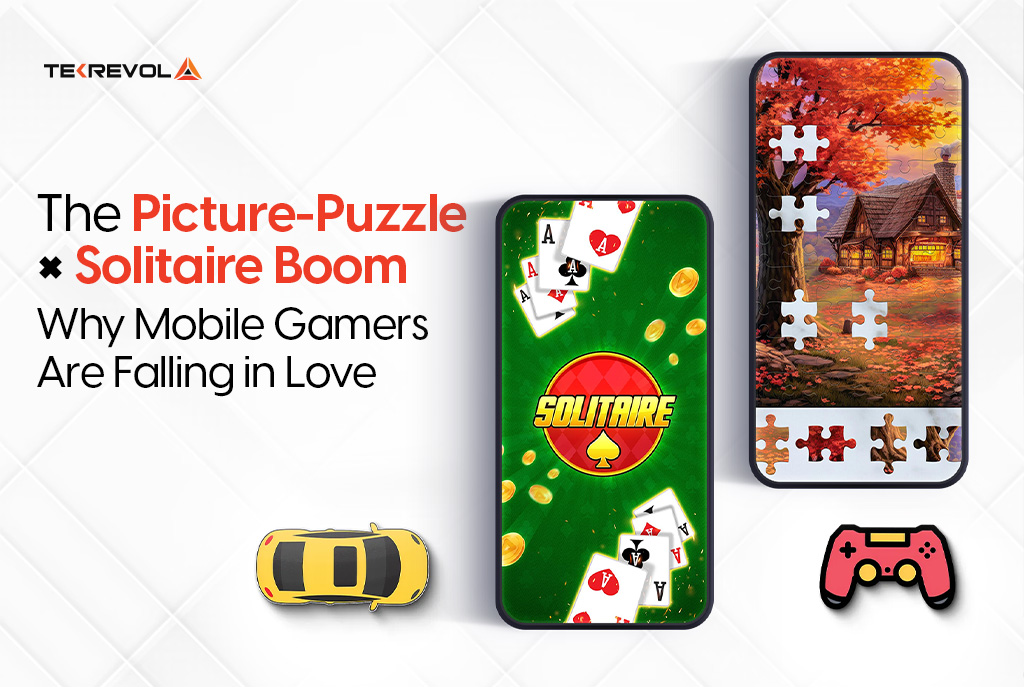
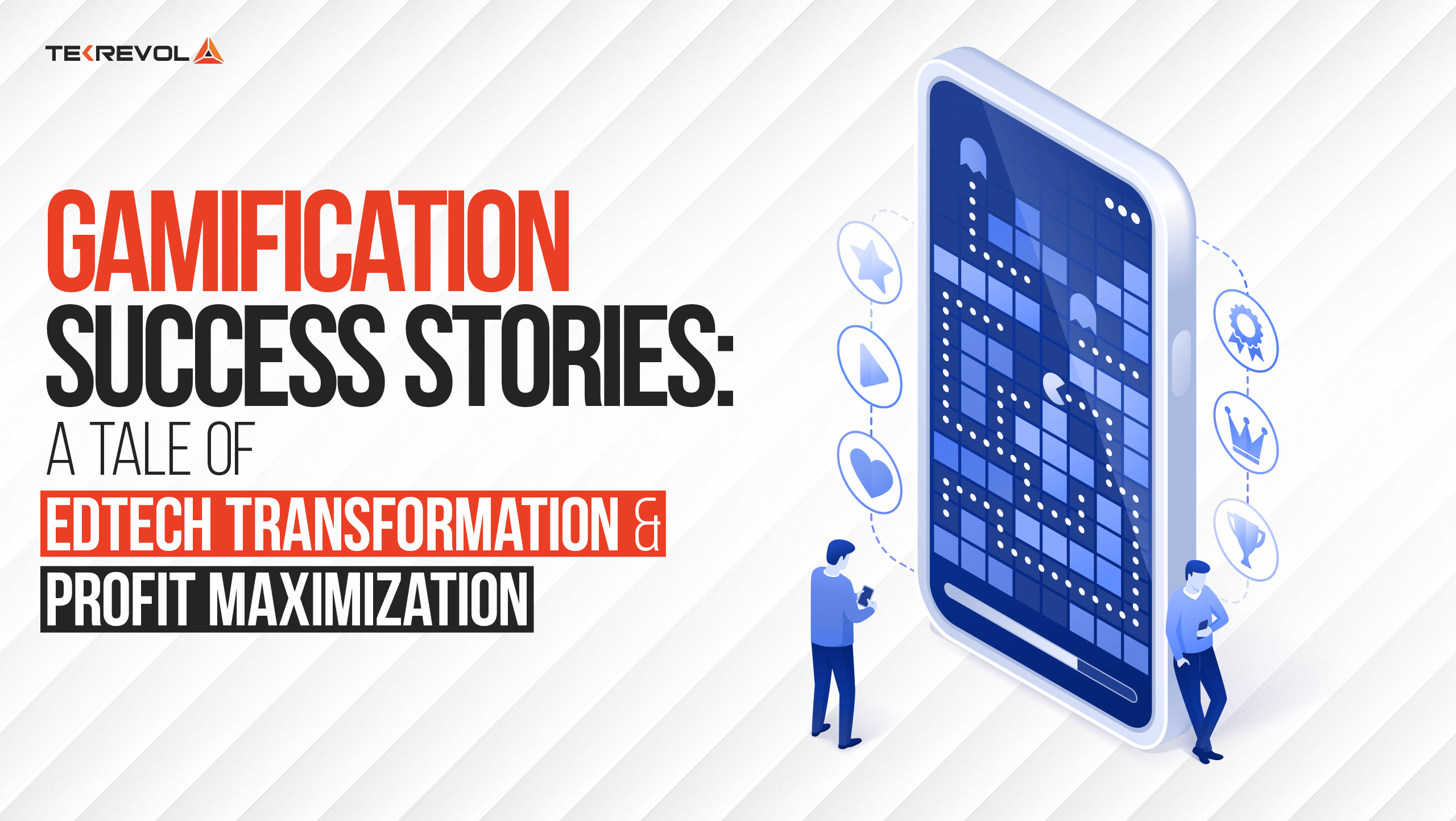
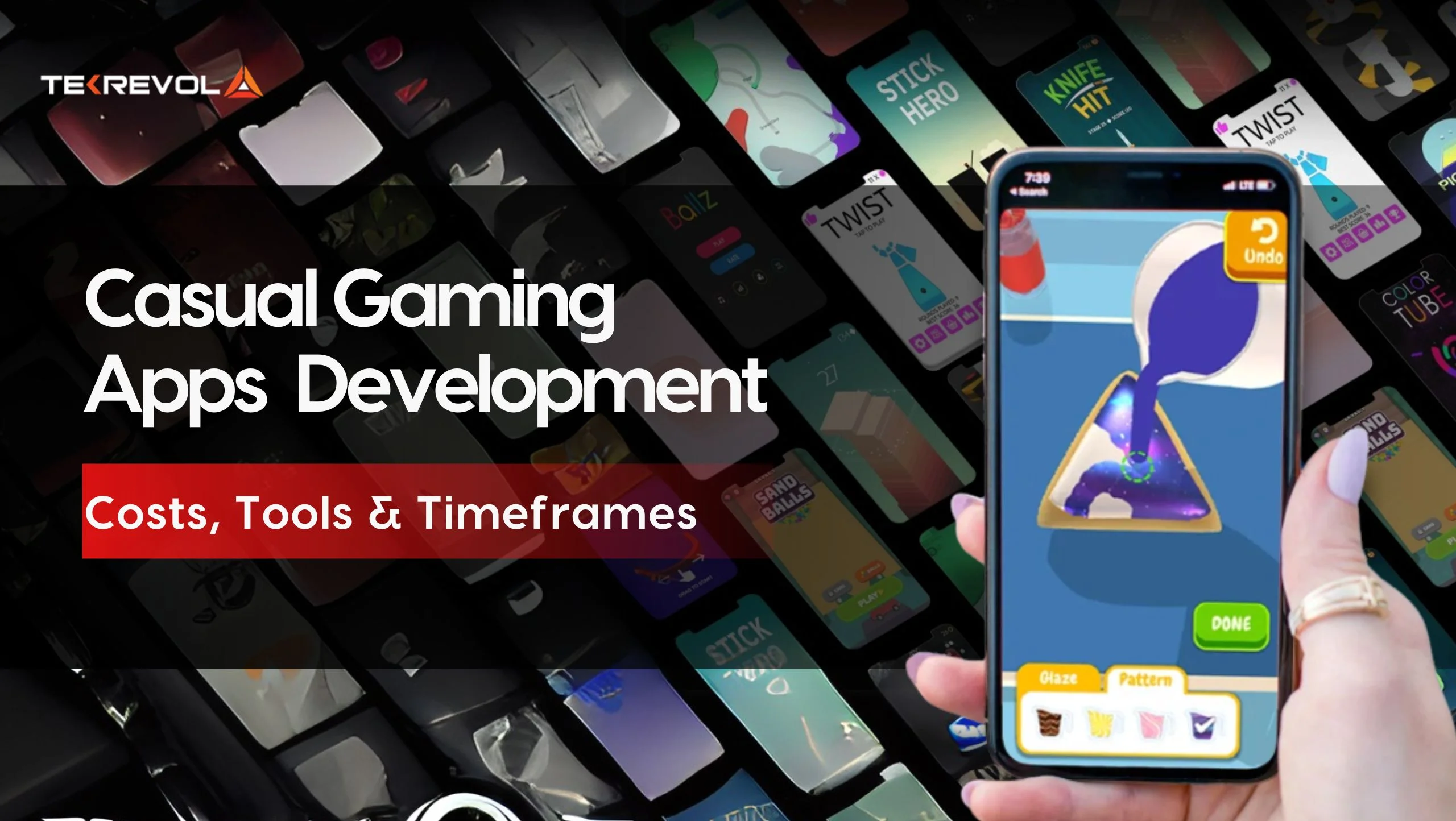

![What is Visual Regression Testing [2025 Definitive Guide]](https://d3r5yd0374231.cloudfront.net/images-tek/uploads/2025/11/Feature-19.jpg)


